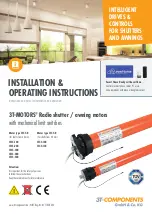
STAC6 Drives and Microstepping Motors:
User Manual
(Discontinued Product)
• 1.8 •
1:
H A R D W A R E
"Auto enable" of the adapter transmitter. Host adapters are required
as PC software typically doesn’t support tri-stating the output of the
serial adapters.
In both 2-wire and 4-wire systems one extra wire is always required
to connect the "Grounds" of all the nodes on the network. Even
though 2-wire and 4-wire systems send differentially, a command
ground connection is absolutely required.
In addition, proper cable shielding is a must. High voltage, high
frequency, high current signals that are present on servo motor
cables can emit a significant amount of electrical interference.
Without proper shielding these signals can disrupt even "noise
tolerant" differential line drivers.
4-Wire RS-485-422 Network
The RS485 implementation is a 4-wire multi-drop network with
separate transmit and receive wires. One pair of wires connects
from the host computer’s TX+ and TX- signals to each of the drive’s
RX+ and RX- terminals. Another pair connects the TX+ and TX-
drive terminals to the host computer’s RX+ and RX- signals. A
common ground terminal is provided on each drive and can be
used to keep all drives at the same ground potential. This terminal
connects internally to the DC power supply return (V-), so if all the
drives on the RS485 network are powered from the same supply, it
is not necessary to connect the logic grounds. Connection of one
drive’s GND terminal to the host computer ground is still required.
Before wiring the entire system, connect each drive individually to
the host computer so a unique address can be assigned to each
drive. Proceed as follows: (Also see figure below)
1. Connect the drive TX+ to the PC’s RX+ terminal.
2. Connect the drive TX- to PC RX-.
3. Connect RX+ to TX+.
4. Connect RX- to TX-.
5. Connect GND to GND.
Getting and Connecting a RS485 4-wire adapter to your
















































